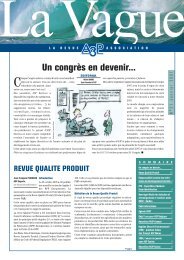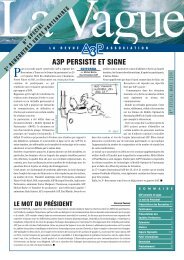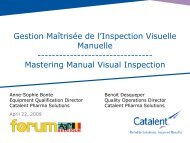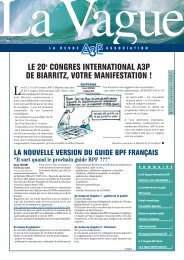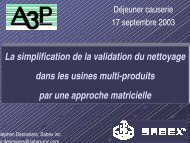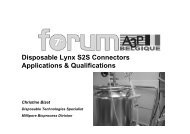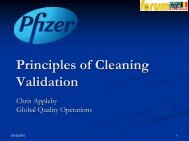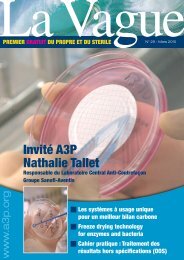La Vague N.4 - A3P
La Vague N.4 - A3P
La Vague N.4 - A3P
You also want an ePaper? Increase the reach of your titles
YUMPU automatically turns print PDFs into web optimized ePapers that Google loves.
A TELIERS INTERACTIFS<br />
customer base then this particular risk element may be<br />
lower.<br />
When it comes to actually implementing a Rapid<br />
Microbiology Test System a number of criteria will<br />
become very important and the ability of the supplier<br />
to provide these should be established at the audit<br />
stage.<br />
Procedures and documentation for the following should<br />
be available<br />
1. Installation 4. Calibration<br />
2. Operation 5. Service<br />
3. Training<br />
So finally the responsibility of the equipment supplier is<br />
to validate their system according to USP or<br />
, or PDA Technical Report 33 and be able to<br />
provide the data to demonstrate this and to facilitate<br />
customers to do the same.<br />
Using the Validation Guidelines<br />
USP /PDA TR33: Validation of Alternative<br />
Microbiological Methods<br />
These chapters give clear guidance on the following criteria<br />
1. Accuracy 5. Linearity<br />
2. Precision 6. Range<br />
3. Specificity 7. Ruggedness<br />
4. Quantification Limit 8. Robustness<br />
I will discuss some of these criteria using the example<br />
of the Millipore Microstar System. The Microstar is a<br />
complete system for the detection and enumeration of<br />
viable microorganisms in filterable samples. Typically<br />
it takes only 1/4 to 1/3 the time of conventional<br />
methods to achieve a comparable result.<br />
The Microstar uses a traditional microbiology technique<br />
(membrane filtration) coupled with ATP bioluminescence<br />
and CCD image analysis to give you comparable<br />
results to the compendial method, but within a<br />
much shorter time frame. The Microstar can be used<br />
for testing water, in-process product and final product<br />
within the Pharmaceutical Industry.<br />
Accuracy<br />
Accuracy can be defined as the closeness of a test<br />
result to the results predicted by the compendial<br />
method. Accuracy is expressed as the percentage recovery<br />
of microorganisms by the test method.<br />
The alternate method must provide an estimate of not<br />
less than 70% of the estimate provided by the compendial<br />
method.<br />
An example is shown below:<br />
Organism Average Percent Recovery<br />
E. coli 95<br />
A. niger 127<br />
P. aeruginosa 82<br />
C. albicans 104<br />
S. aureus 97<br />
B. subtilis 108<br />
Precision<br />
Precision can be defined as the degree of agreement<br />
among test results when the procedure is applied to<br />
multiple samplings of suspensions of microorganisms<br />
across the range of a test. These have been shown to be<br />
equivalent when using Microstar to compendial<br />
methods<br />
Specificity<br />
Specificity can be defined as the ability to detect a<br />
range of microorganisms, which demonstrate that the<br />
method is fit for purpose.<br />
The method’s compatibility with the different types of<br />
sample matrices should also be shown.<br />
To determine this screen the method against a representative<br />
range of microorganisms and a range of sample<br />
types that are appropriate to the method.<br />
Acceptance Criteria: All microorganisms selected as<br />
representative are successfully detected and enumerated<br />
in the sample matrices. The Microstar System has<br />
successfully been used to detect a very wide range of<br />
organisms in a huge range of sample matrices ranging<br />
from the straightforward such as water to the more<br />
challenging such as mammalian cell culture suspensions<br />
Quantification Limit<br />
Quantification Limit can be defined as the lowest number<br />
of microorganisms that can be determined with<br />
acceptable precision and accuracy under the stated<br />
experimental conditions.<br />
Z-Statistic and p-value determine whether or not data<br />
are statistically similar. The following table illustrates<br />
this.<br />
Organism MicroStar HA MF Statistically<br />
Similar?<br />
E. coli 10.6 9.7 Yes<br />
A. niger 9.6 8.2 Yes<br />
P. aeruginosa 8.8 9.1 Yes<br />
C. albicans 10.4 8.8 Yes<br />
S. aureus 14.5 12.8 Yes<br />
B. subtilis 8.0 7.0 Yes<br />
Linearity and Range<br />
Linearity can be defined as the ability of the test<br />
method to elicit results, which are proportional to the<br />
concentration of microorganisms present in the sample<br />
within a given range. Microstar shows excellent linearity<br />
up to counts of around 100 cfu per membrane. If<br />
higher counts than this are expected a dilution step<br />
may be recommended.<br />
Ruggedness<br />
Ruggedness can be defined as the degree of precision<br />
of test results obtained by analysis of the same samples<br />
under a variety of normal test conditions, such as different<br />
analysts, different instruments, different lots of<br />
reagent, etc. It is often best suited to determination by<br />
the test supplier who has easy access to multiple instruments<br />
and batches of components. Millipore has<br />
conducted extensive testing using different reagent lots<br />
on different Microstar equipment. Extensive shipping<br />
trials have also been conducted on both reagents and<br />
equipment<br />
Robustness<br />
Robustness can be defined as a measure of a method’s<br />
capacity to remain unaffected by small, but deliberate<br />
variations in method parameters, and provides an indication<br />
of its reliability during normal usage. Again this<br />
is often best suited to determination by the equipment<br />
supplier. Millipore has validated many areas of robustness<br />
in relation to the Microstar including false positive<br />
rates and incubation times. The Microstar method has<br />
been shown to be highly robust.<br />
Finally to summarise, the implementation of a Rapid<br />
Microbilogical Test Method can be achieved much more<br />
smoothly by first of all a careful audit of the suppliers<br />
capabilities and then by using these capabilities in<br />
conjunction with the available regulatory guidelines to<br />
validate your new test method. ■<br />
9




